Comprehensive Financial Analysis of ANZ Bank's Performance
VerifiedAdded on 2023/04/23
|11
|1487
|408
Report
AI Summary
This report provides a comprehensive financial analysis of the Australia and New Zealand Banking Group (ANZ) Bank. It examines the bank's capital structure, revealing a significant reliance on debt financing. The report calculates the Weighted Average Cost of Capital (WACC) and assesses the stock's return relative to its associated risk using the Capital Asset Pricing Model (CAPM), indicating potential underperformance. A comparative analysis of ANZ's capital structure with National Australia Bank (NAB) is also included. Furthermore, the report delves into ratio analysis, evaluating profitability, solvency, asset utilization, and market value ratios to gauge ANZ's financial health. It also addresses the bank's accountability and integrity in light of past ethical issues, concluding that while profitability improved, there were shortcomings in efficiency, solvency, and operational risk management.
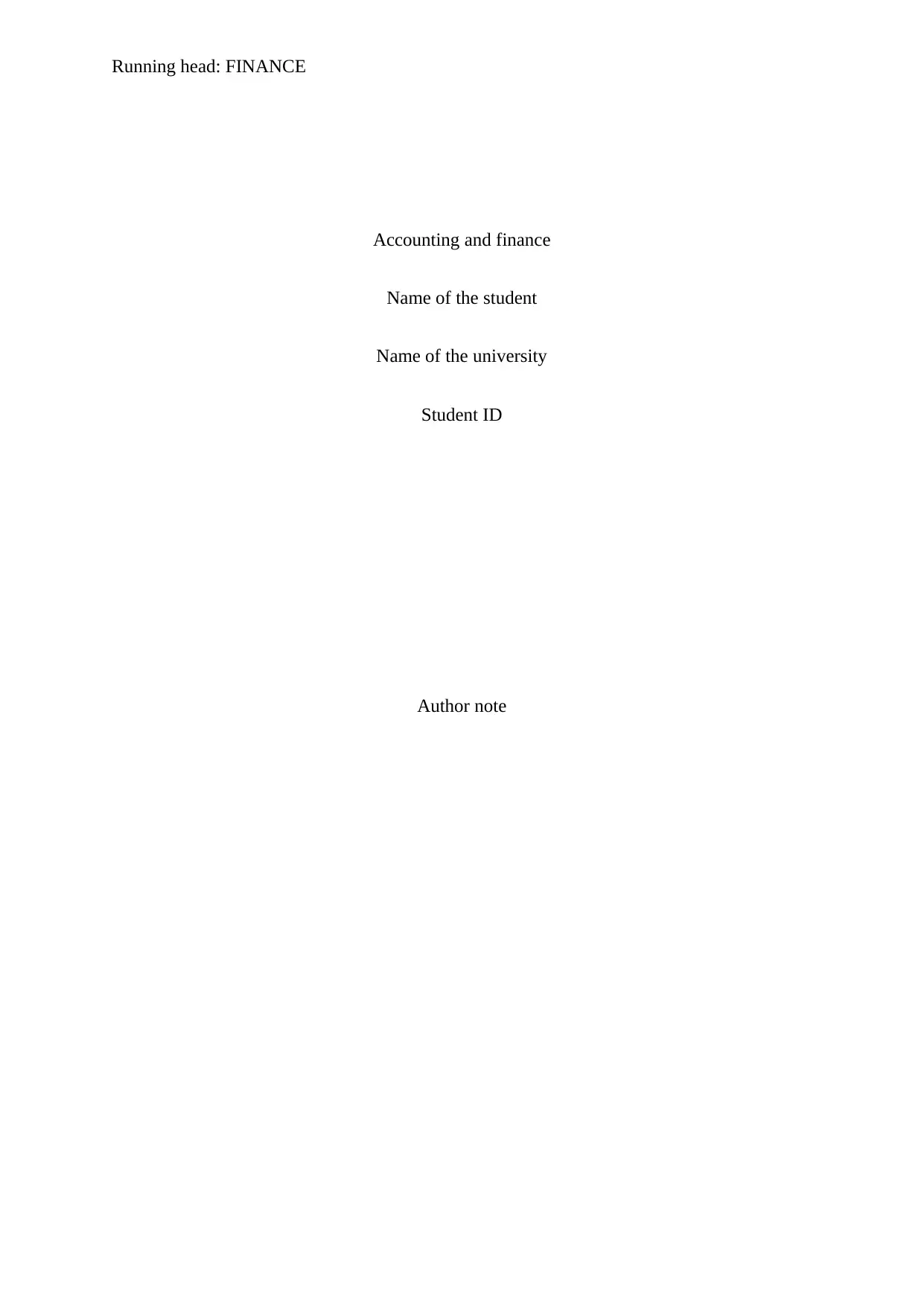
Running head: FINANCE
Accounting and finance
Name of the student
Name of the university
Student ID
Author note
Accounting and finance
Name of the student
Name of the university
Student ID
Author note
Paraphrase This Document
Need a fresh take? Get an instant paraphrase of this document with our AI Paraphraser
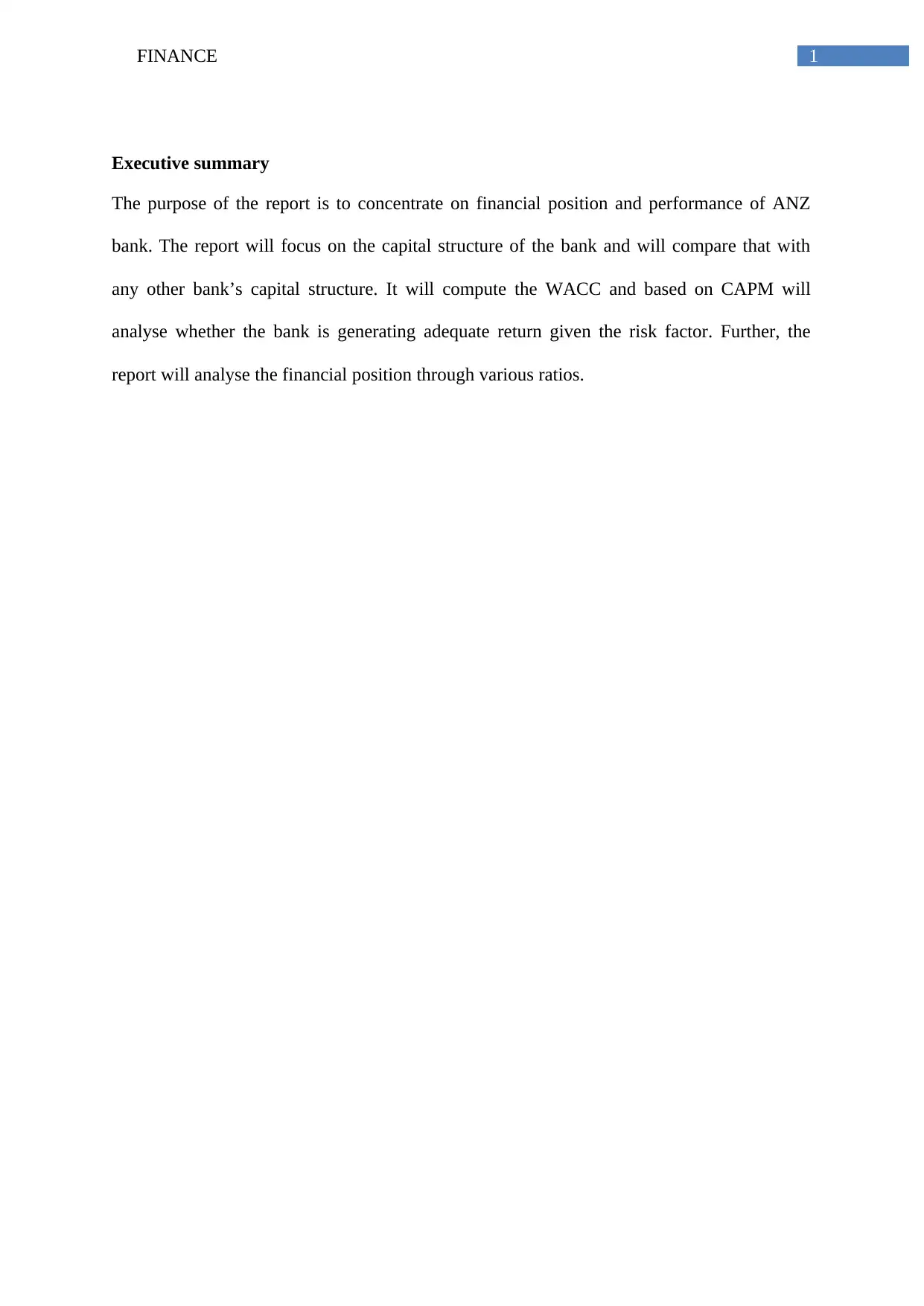
1FINANCE
Executive summary
The purpose of the report is to concentrate on financial position and performance of ANZ
bank. The report will focus on the capital structure of the bank and will compare that with
any other bank’s capital structure. It will compute the WACC and based on CAPM will
analyse whether the bank is generating adequate return given the risk factor. Further, the
report will analyse the financial position through various ratios.
Executive summary
The purpose of the report is to concentrate on financial position and performance of ANZ
bank. The report will focus on the capital structure of the bank and will compare that with
any other bank’s capital structure. It will compute the WACC and based on CAPM will
analyse whether the bank is generating adequate return given the risk factor. Further, the
report will analyse the financial position through various ratios.
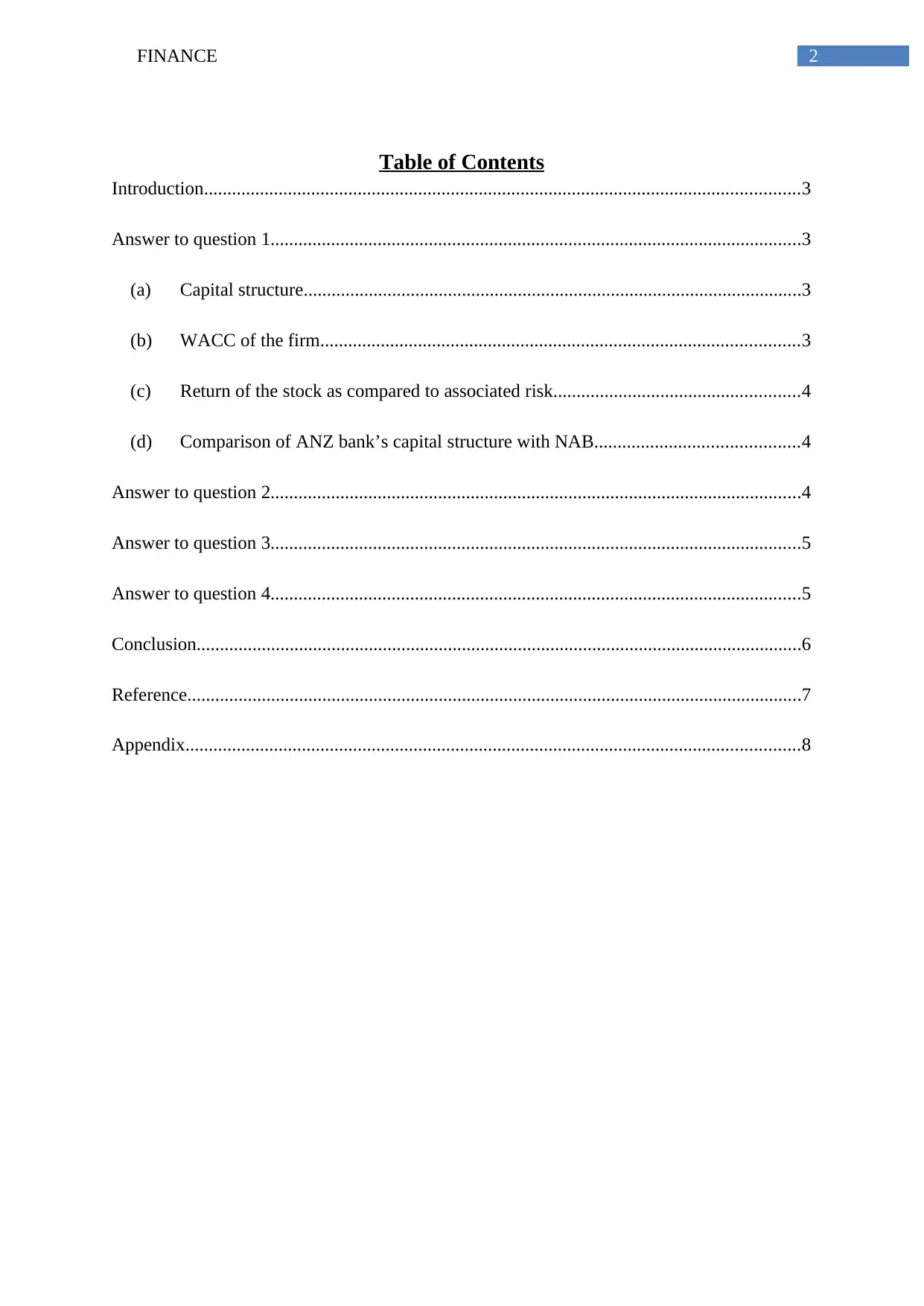
2FINANCE
Table of Contents
Introduction................................................................................................................................3
Answer to question 1..................................................................................................................3
(a) Capital structure...........................................................................................................3
(b) WACC of the firm.......................................................................................................3
(c) Return of the stock as compared to associated risk.....................................................4
(d) Comparison of ANZ bank’s capital structure with NAB............................................4
Answer to question 2..................................................................................................................4
Answer to question 3..................................................................................................................5
Answer to question 4..................................................................................................................5
Conclusion..................................................................................................................................6
Reference....................................................................................................................................7
Appendix....................................................................................................................................8
Table of Contents
Introduction................................................................................................................................3
Answer to question 1..................................................................................................................3
(a) Capital structure...........................................................................................................3
(b) WACC of the firm.......................................................................................................3
(c) Return of the stock as compared to associated risk.....................................................4
(d) Comparison of ANZ bank’s capital structure with NAB............................................4
Answer to question 2..................................................................................................................4
Answer to question 3..................................................................................................................5
Answer to question 4..................................................................................................................5
Conclusion..................................................................................................................................6
Reference....................................................................................................................................7
Appendix....................................................................................................................................8
⊘ This is a preview!⊘
Do you want full access?
Subscribe today to unlock all pages.

Trusted by 1+ million students worldwide
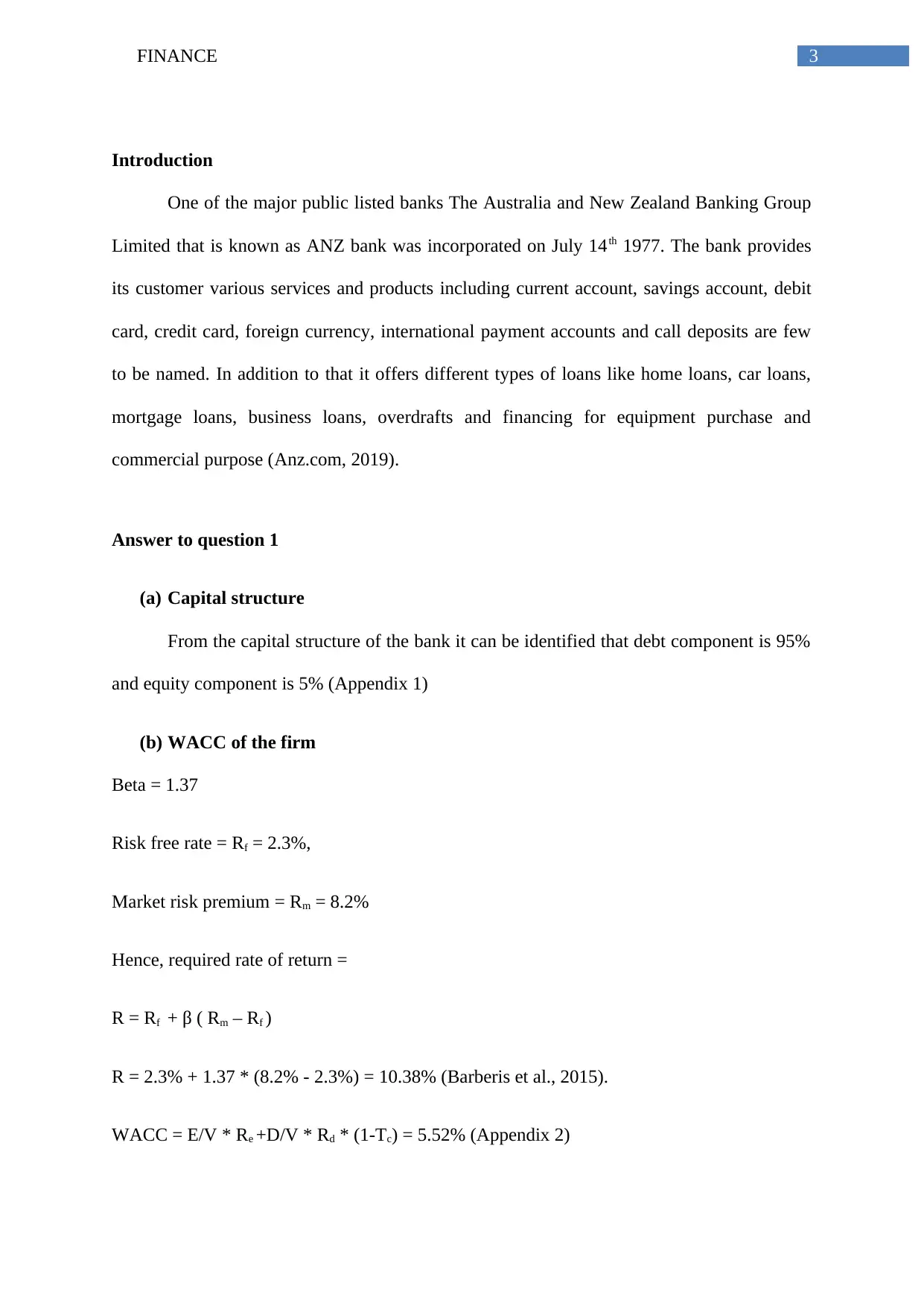
3FINANCE
Introduction
One of the major public listed banks The Australia and New Zealand Banking Group
Limited that is known as ANZ bank was incorporated on July 14th 1977. The bank provides
its customer various services and products including current account, savings account, debit
card, credit card, foreign currency, international payment accounts and call deposits are few
to be named. In addition to that it offers different types of loans like home loans, car loans,
mortgage loans, business loans, overdrafts and financing for equipment purchase and
commercial purpose (Anz.com, 2019).
Answer to question 1
(a) Capital structure
From the capital structure of the bank it can be identified that debt component is 95%
and equity component is 5% (Appendix 1)
(b) WACC of the firm
Beta = 1.37
Risk free rate = Rf = 2.3%,
Market risk premium = Rm = 8.2%
Hence, required rate of return =
R = Rf + β ( Rm – Rf )
R = 2.3% + 1.37 * (8.2% - 2.3%) = 10.38% (Barberis et al., 2015).
WACC = E/V * Re +D/V * Rd * (1-Tc) = 5.52% (Appendix 2)
Introduction
One of the major public listed banks The Australia and New Zealand Banking Group
Limited that is known as ANZ bank was incorporated on July 14th 1977. The bank provides
its customer various services and products including current account, savings account, debit
card, credit card, foreign currency, international payment accounts and call deposits are few
to be named. In addition to that it offers different types of loans like home loans, car loans,
mortgage loans, business loans, overdrafts and financing for equipment purchase and
commercial purpose (Anz.com, 2019).
Answer to question 1
(a) Capital structure
From the capital structure of the bank it can be identified that debt component is 95%
and equity component is 5% (Appendix 1)
(b) WACC of the firm
Beta = 1.37
Risk free rate = Rf = 2.3%,
Market risk premium = Rm = 8.2%
Hence, required rate of return =
R = Rf + β ( Rm – Rf )
R = 2.3% + 1.37 * (8.2% - 2.3%) = 10.38% (Barberis et al., 2015).
WACC = E/V * Re +D/V * Rd * (1-Tc) = 5.52% (Appendix 2)
Paraphrase This Document
Need a fresh take? Get an instant paraphrase of this document with our AI Paraphraser
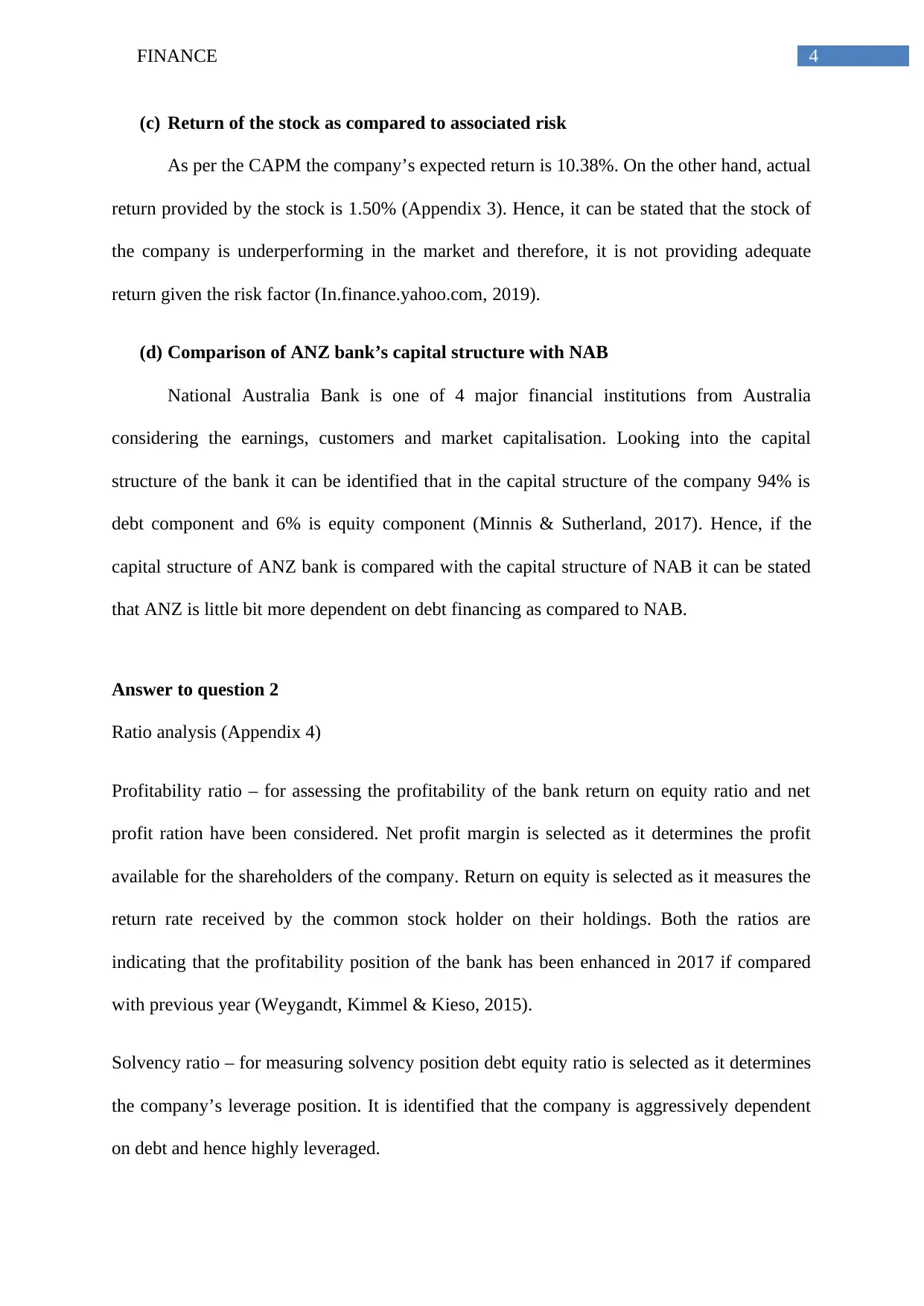
4FINANCE
(c) Return of the stock as compared to associated risk
As per the CAPM the company’s expected return is 10.38%. On the other hand, actual
return provided by the stock is 1.50% (Appendix 3). Hence, it can be stated that the stock of
the company is underperforming in the market and therefore, it is not providing adequate
return given the risk factor (In.finance.yahoo.com, 2019).
(d) Comparison of ANZ bank’s capital structure with NAB
National Australia Bank is one of 4 major financial institutions from Australia
considering the earnings, customers and market capitalisation. Looking into the capital
structure of the bank it can be identified that in the capital structure of the company 94% is
debt component and 6% is equity component (Minnis & Sutherland, 2017). Hence, if the
capital structure of ANZ bank is compared with the capital structure of NAB it can be stated
that ANZ is little bit more dependent on debt financing as compared to NAB.
Answer to question 2
Ratio analysis (Appendix 4)
Profitability ratio – for assessing the profitability of the bank return on equity ratio and net
profit ration have been considered. Net profit margin is selected as it determines the profit
available for the shareholders of the company. Return on equity is selected as it measures the
return rate received by the common stock holder on their holdings. Both the ratios are
indicating that the profitability position of the bank has been enhanced in 2017 if compared
with previous year (Weygandt, Kimmel & Kieso, 2015).
Solvency ratio – for measuring solvency position debt equity ratio is selected as it determines
the company’s leverage position. It is identified that the company is aggressively dependent
on debt and hence highly leveraged.
(c) Return of the stock as compared to associated risk
As per the CAPM the company’s expected return is 10.38%. On the other hand, actual
return provided by the stock is 1.50% (Appendix 3). Hence, it can be stated that the stock of
the company is underperforming in the market and therefore, it is not providing adequate
return given the risk factor (In.finance.yahoo.com, 2019).
(d) Comparison of ANZ bank’s capital structure with NAB
National Australia Bank is one of 4 major financial institutions from Australia
considering the earnings, customers and market capitalisation. Looking into the capital
structure of the bank it can be identified that in the capital structure of the company 94% is
debt component and 6% is equity component (Minnis & Sutherland, 2017). Hence, if the
capital structure of ANZ bank is compared with the capital structure of NAB it can be stated
that ANZ is little bit more dependent on debt financing as compared to NAB.
Answer to question 2
Ratio analysis (Appendix 4)
Profitability ratio – for assessing the profitability of the bank return on equity ratio and net
profit ration have been considered. Net profit margin is selected as it determines the profit
available for the shareholders of the company. Return on equity is selected as it measures the
return rate received by the common stock holder on their holdings. Both the ratios are
indicating that the profitability position of the bank has been enhanced in 2017 if compared
with previous year (Weygandt, Kimmel & Kieso, 2015).
Solvency ratio – for measuring solvency position debt equity ratio is selected as it determines
the company’s leverage position. It is identified that the company is aggressively dependent
on debt and hence highly leveraged.
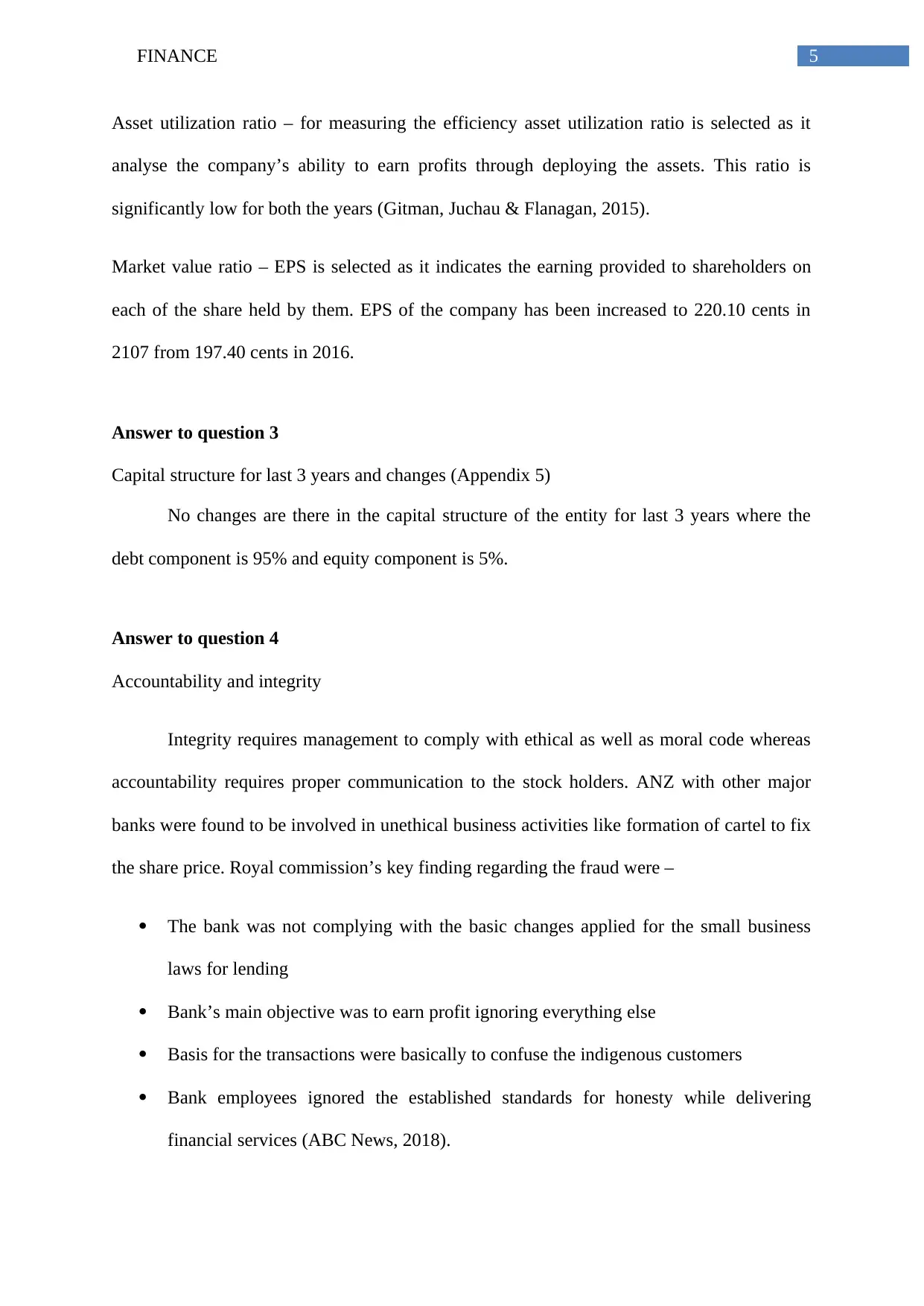
5FINANCE
Asset utilization ratio – for measuring the efficiency asset utilization ratio is selected as it
analyse the company’s ability to earn profits through deploying the assets. This ratio is
significantly low for both the years (Gitman, Juchau & Flanagan, 2015).
Market value ratio – EPS is selected as it indicates the earning provided to shareholders on
each of the share held by them. EPS of the company has been increased to 220.10 cents in
2107 from 197.40 cents in 2016.
Answer to question 3
Capital structure for last 3 years and changes (Appendix 5)
No changes are there in the capital structure of the entity for last 3 years where the
debt component is 95% and equity component is 5%.
Answer to question 4
Accountability and integrity
Integrity requires management to comply with ethical as well as moral code whereas
accountability requires proper communication to the stock holders. ANZ with other major
banks were found to be involved in unethical business activities like formation of cartel to fix
the share price. Royal commission’s key finding regarding the fraud were –
The bank was not complying with the basic changes applied for the small business
laws for lending
Bank’s main objective was to earn profit ignoring everything else
Basis for the transactions were basically to confuse the indigenous customers
Bank employees ignored the established standards for honesty while delivering
financial services (ABC News, 2018).
Asset utilization ratio – for measuring the efficiency asset utilization ratio is selected as it
analyse the company’s ability to earn profits through deploying the assets. This ratio is
significantly low for both the years (Gitman, Juchau & Flanagan, 2015).
Market value ratio – EPS is selected as it indicates the earning provided to shareholders on
each of the share held by them. EPS of the company has been increased to 220.10 cents in
2107 from 197.40 cents in 2016.
Answer to question 3
Capital structure for last 3 years and changes (Appendix 5)
No changes are there in the capital structure of the entity for last 3 years where the
debt component is 95% and equity component is 5%.
Answer to question 4
Accountability and integrity
Integrity requires management to comply with ethical as well as moral code whereas
accountability requires proper communication to the stock holders. ANZ with other major
banks were found to be involved in unethical business activities like formation of cartel to fix
the share price. Royal commission’s key finding regarding the fraud were –
The bank was not complying with the basic changes applied for the small business
laws for lending
Bank’s main objective was to earn profit ignoring everything else
Basis for the transactions were basically to confuse the indigenous customers
Bank employees ignored the established standards for honesty while delivering
financial services (ABC News, 2018).
⊘ This is a preview!⊘
Do you want full access?
Subscribe today to unlock all pages.

Trusted by 1+ million students worldwide
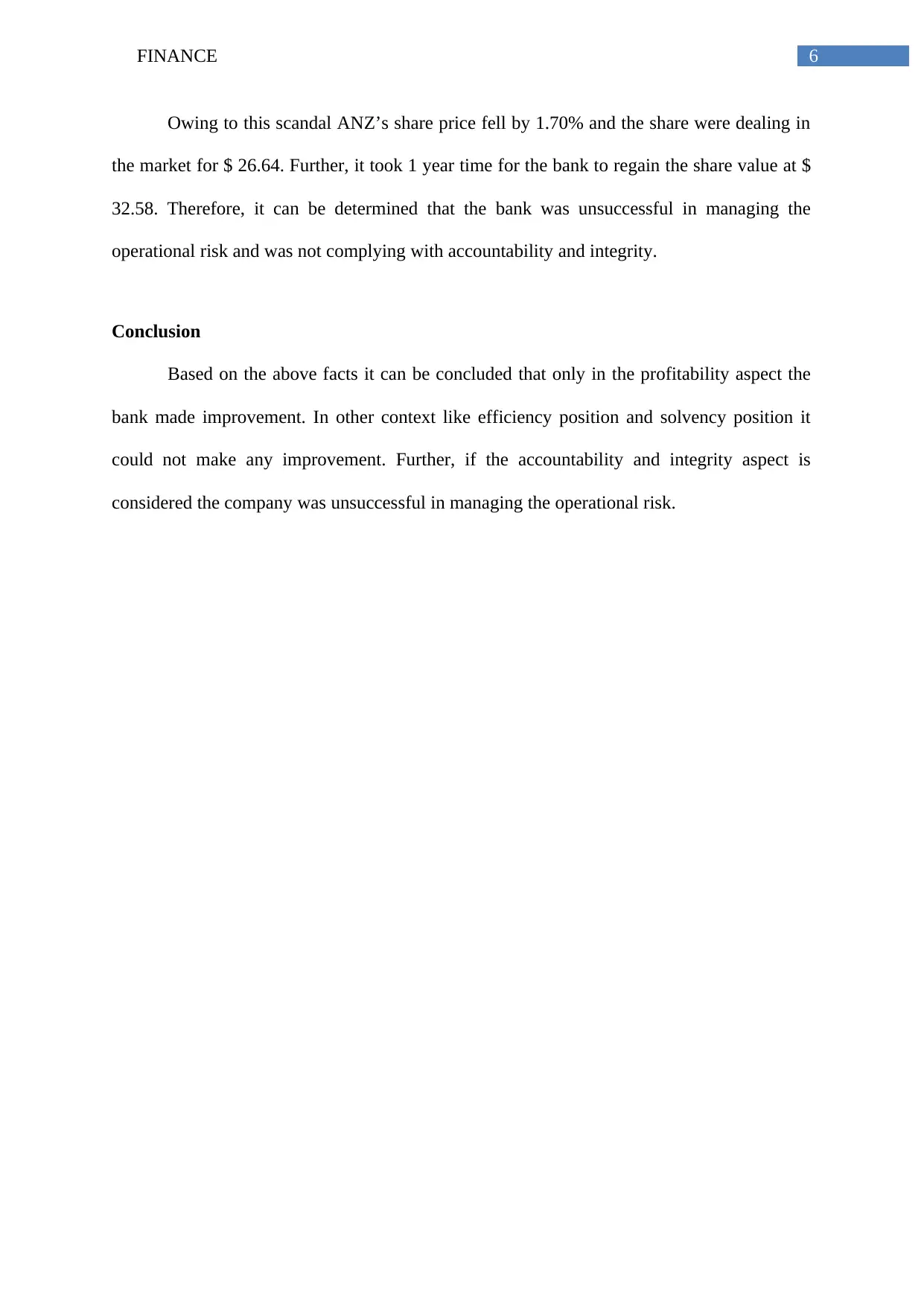
6FINANCE
Owing to this scandal ANZ’s share price fell by 1.70% and the share were dealing in
the market for $ 26.64. Further, it took 1 year time for the bank to regain the share value at $
32.58. Therefore, it can be determined that the bank was unsuccessful in managing the
operational risk and was not complying with accountability and integrity.
Conclusion
Based on the above facts it can be concluded that only in the profitability aspect the
bank made improvement. In other context like efficiency position and solvency position it
could not make any improvement. Further, if the accountability and integrity aspect is
considered the company was unsuccessful in managing the operational risk.
Owing to this scandal ANZ’s share price fell by 1.70% and the share were dealing in
the market for $ 26.64. Further, it took 1 year time for the bank to regain the share value at $
32.58. Therefore, it can be determined that the bank was unsuccessful in managing the
operational risk and was not complying with accountability and integrity.
Conclusion
Based on the above facts it can be concluded that only in the profitability aspect the
bank made improvement. In other context like efficiency position and solvency position it
could not make any improvement. Further, if the accountability and integrity aspect is
considered the company was unsuccessful in managing the operational risk.
Paraphrase This Document
Need a fresh take? Get an instant paraphrase of this document with our AI Paraphraser
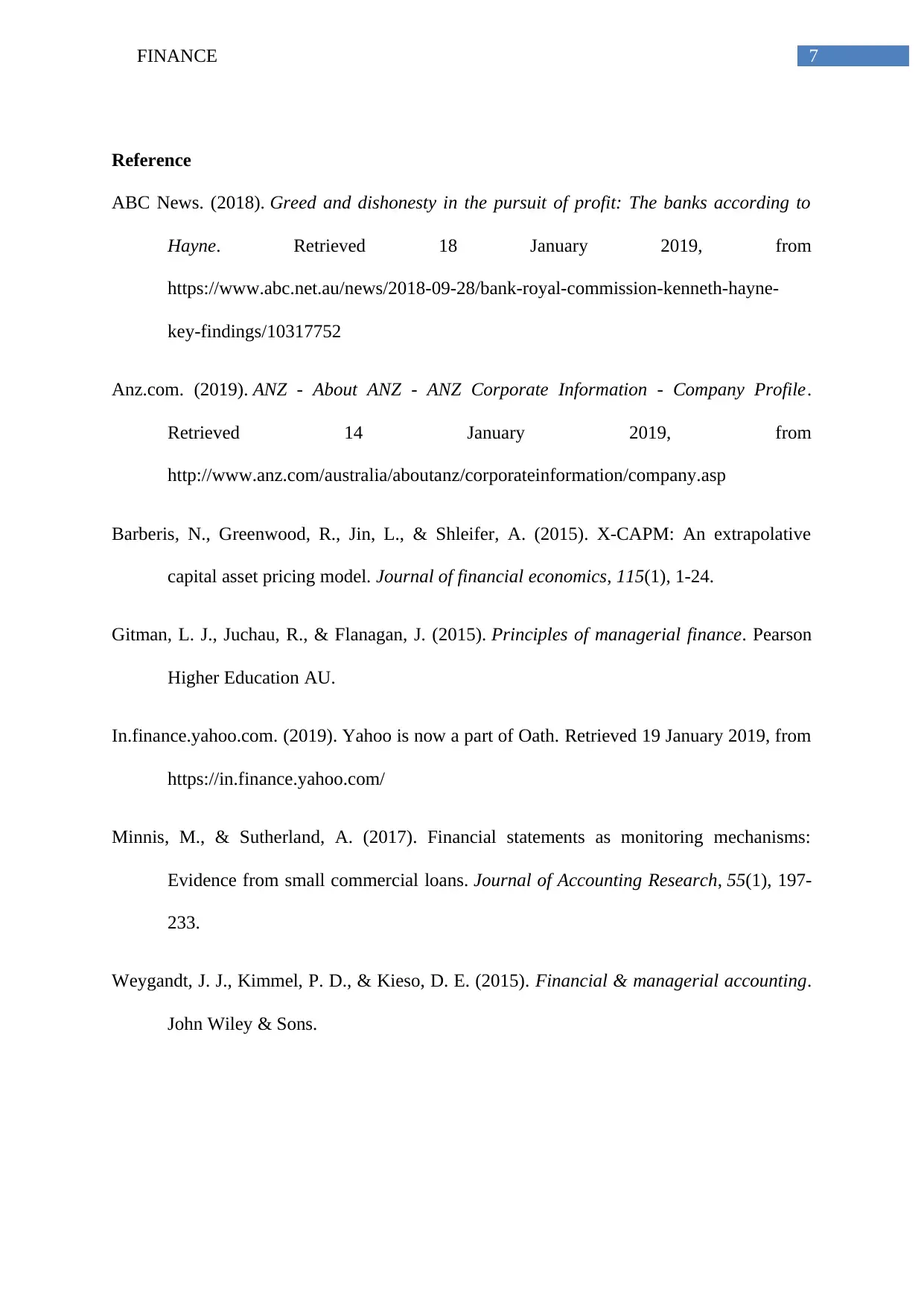
7FINANCE
Reference
ABC News. (2018). Greed and dishonesty in the pursuit of profit: The banks according to
Hayne. Retrieved 18 January 2019, from
https://www.abc.net.au/news/2018-09-28/bank-royal-commission-kenneth-hayne-
key-findings/10317752
Anz.com. (2019). ANZ - About ANZ - ANZ Corporate Information - Company Profile.
Retrieved 14 January 2019, from
http://www.anz.com/australia/aboutanz/corporateinformation/company.asp
Barberis, N., Greenwood, R., Jin, L., & Shleifer, A. (2015). X-CAPM: An extrapolative
capital asset pricing model. Journal of financial economics, 115(1), 1-24.
Gitman, L. J., Juchau, R., & Flanagan, J. (2015). Principles of managerial finance. Pearson
Higher Education AU.
In.finance.yahoo.com. (2019). Yahoo is now a part of Oath. Retrieved 19 January 2019, from
https://in.finance.yahoo.com/
Minnis, M., & Sutherland, A. (2017). Financial statements as monitoring mechanisms:
Evidence from small commercial loans. Journal of Accounting Research, 55(1), 197-
233.
Weygandt, J. J., Kimmel, P. D., & Kieso, D. E. (2015). Financial & managerial accounting.
John Wiley & Sons.
Reference
ABC News. (2018). Greed and dishonesty in the pursuit of profit: The banks according to
Hayne. Retrieved 18 January 2019, from
https://www.abc.net.au/news/2018-09-28/bank-royal-commission-kenneth-hayne-
key-findings/10317752
Anz.com. (2019). ANZ - About ANZ - ANZ Corporate Information - Company Profile.
Retrieved 14 January 2019, from
http://www.anz.com/australia/aboutanz/corporateinformation/company.asp
Barberis, N., Greenwood, R., Jin, L., & Shleifer, A. (2015). X-CAPM: An extrapolative
capital asset pricing model. Journal of financial economics, 115(1), 1-24.
Gitman, L. J., Juchau, R., & Flanagan, J. (2015). Principles of managerial finance. Pearson
Higher Education AU.
In.finance.yahoo.com. (2019). Yahoo is now a part of Oath. Retrieved 19 January 2019, from
https://in.finance.yahoo.com/
Minnis, M., & Sutherland, A. (2017). Financial statements as monitoring mechanisms:
Evidence from small commercial loans. Journal of Accounting Research, 55(1), 197-
233.
Weygandt, J. J., Kimmel, P. D., & Kieso, D. E. (2015). Financial & managerial accounting.
John Wiley & Sons.
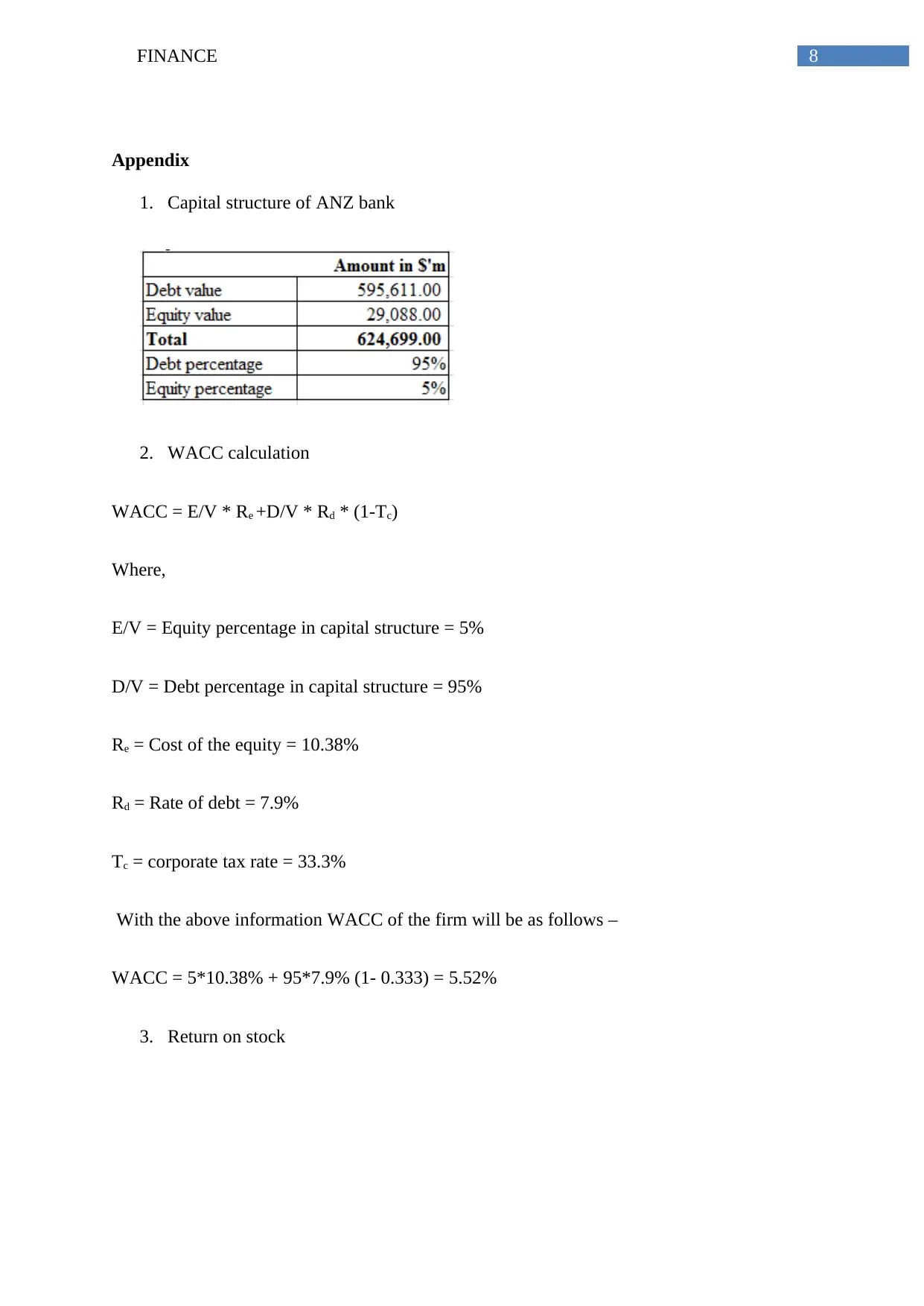
8FINANCE
Appendix
1. Capital structure of ANZ bank
2. WACC calculation
WACC = E/V * Re +D/V * Rd * (1-Tc)
Where,
E/V = Equity percentage in capital structure = 5%
D/V = Debt percentage in capital structure = 95%
Re = Cost of the equity = 10.38%
Rd = Rate of debt = 7.9%
Tc = corporate tax rate = 33.3%
With the above information WACC of the firm will be as follows –
WACC = 5*10.38% + 95*7.9% (1- 0.333) = 5.52%
3. Return on stock
Appendix
1. Capital structure of ANZ bank
2. WACC calculation
WACC = E/V * Re +D/V * Rd * (1-Tc)
Where,
E/V = Equity percentage in capital structure = 5%
D/V = Debt percentage in capital structure = 95%
Re = Cost of the equity = 10.38%
Rd = Rate of debt = 7.9%
Tc = corporate tax rate = 33.3%
With the above information WACC of the firm will be as follows –
WACC = 5*10.38% + 95*7.9% (1- 0.333) = 5.52%
3. Return on stock
⊘ This is a preview!⊘
Do you want full access?
Subscribe today to unlock all pages.

Trusted by 1+ million students worldwide
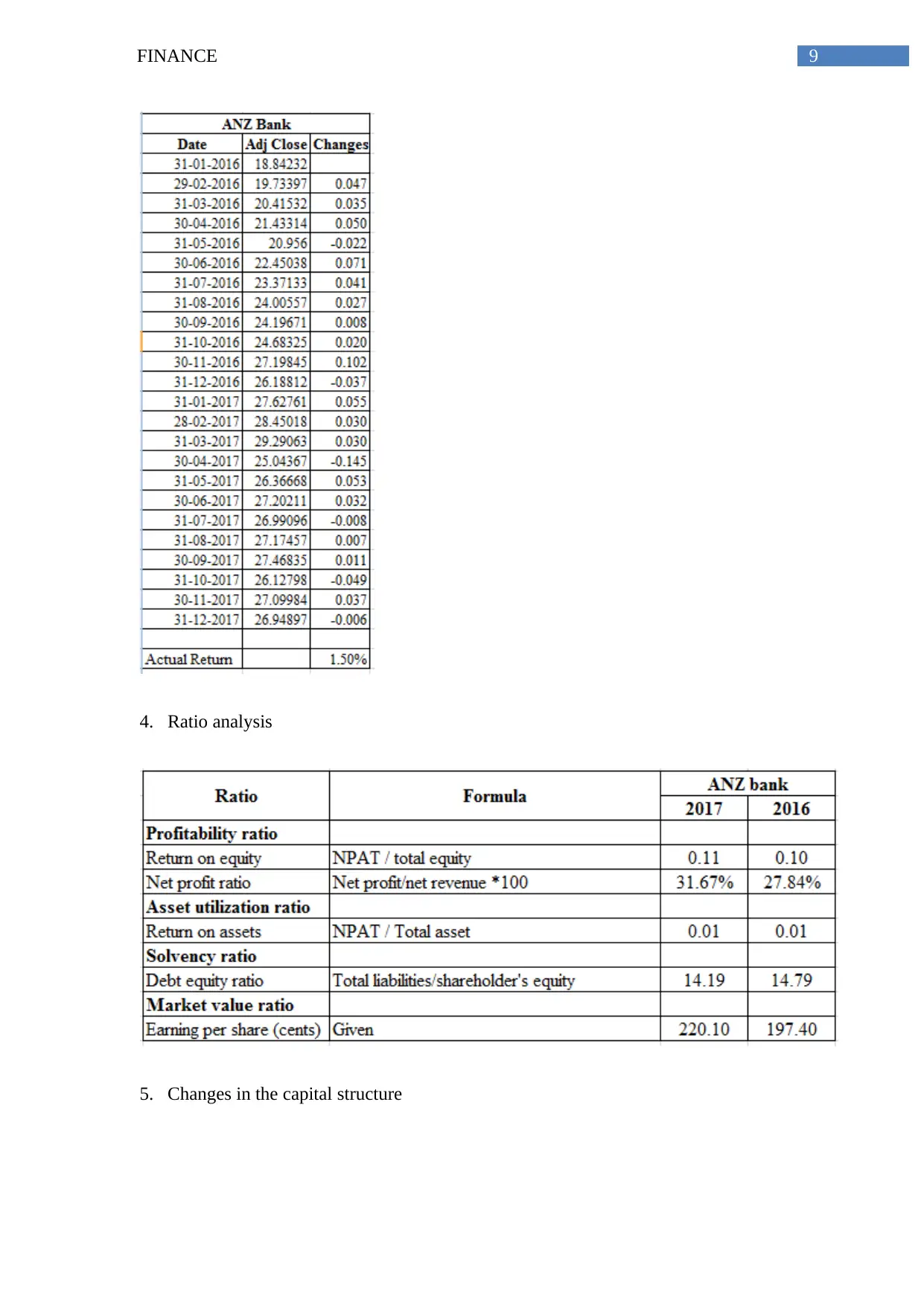
9FINANCE
4. Ratio analysis
5. Changes in the capital structure
4. Ratio analysis
5. Changes in the capital structure
Paraphrase This Document
Need a fresh take? Get an instant paraphrase of this document with our AI Paraphraser
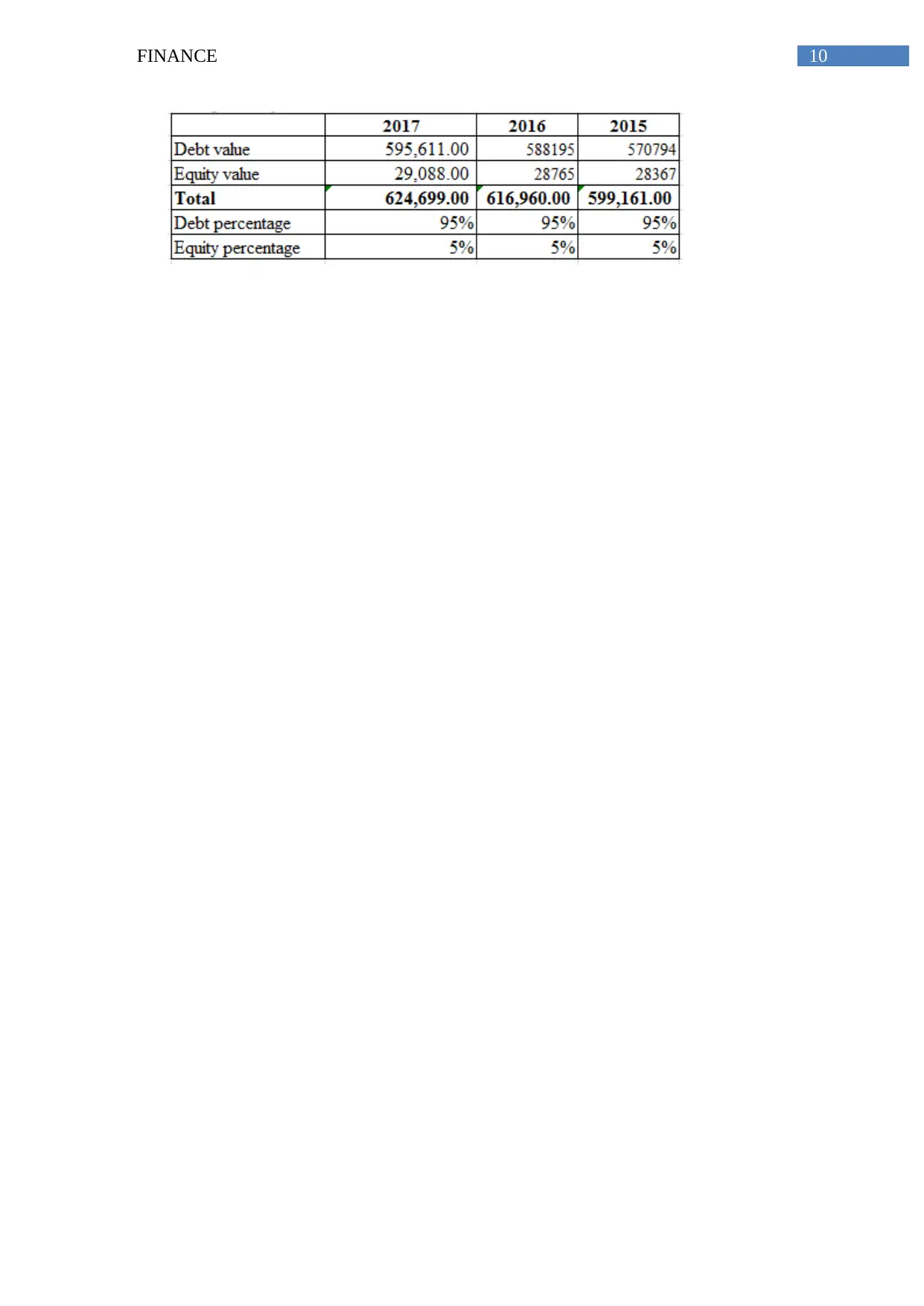
10FINANCE
1 out of 11
Related Documents
Your All-in-One AI-Powered Toolkit for Academic Success.
+13062052269
info@desklib.com
Available 24*7 on WhatsApp / Email
![[object Object]](/_next/static/media/star-bottom.7253800d.svg)
Unlock your academic potential
Copyright © 2020–2025 A2Z Services. All Rights Reserved. Developed and managed by ZUCOL.





